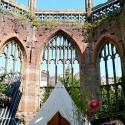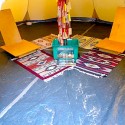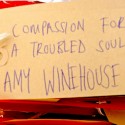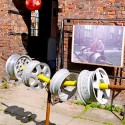12\08\2011
Written by Narayana
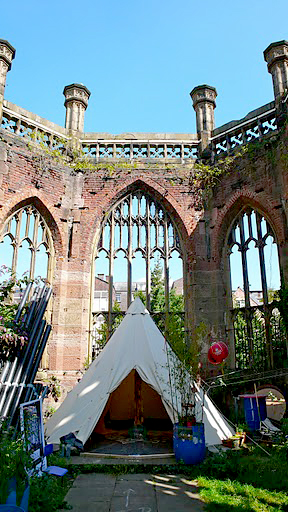
Compassion at The Bombed-Out Church \ Liverpool UK
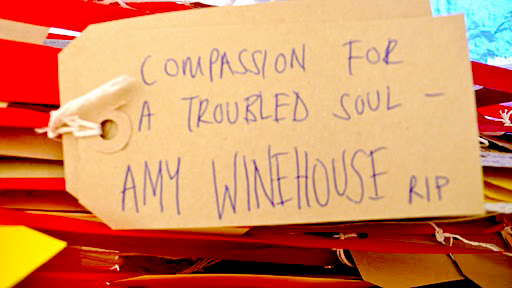
Behind the glossy high rises, new museums, restaurants and glimmer hotels built around the revived port city of Liverpool, England lays an urban ruin. This is no forgotten wreckage bearing in mind that the city of Liverpool is filled with hundreds of empty and deteriorated buildings. One could even easily mistake this dilapidated burned out ecclesiastical structure as the result of this weeks riots throughout Liverpool. This is St. Luke’s Church, known to local citizens as the Bombed-Out Church. Since it’s Capital of Culture status in 2008, much of Liverpool’s urban decay still remains untouched. The church started construction in 1811 was completed in 1831, making it one of the city’s oldest buildings.
Surrounded by popular cafes, hole-in-the-wall pubs, student haunts and Chinatown’s spice route of takeaway joints, the Bombed-Out Church is a gem many simply walk past every day. It doesn’t look like much until one goes inside the old building which is surrounded by an ornate iron gate, manicured gardens and an occasional group of crack-heads.
written by José Carlos Diaz.
 Inside, the roof and windows are long gone, leaving a roofless and windowless retreat. Why do you ask? Well, at 3:30am on 6 May, 1941 during the ‘May Blitz’, it was bombed by the Nazi Army. A firebomb caused a smouldering blaze that lasted for seven days and razed the building’s original features. The Liverpool City Council purchased this ruin from the Church of England in 1968. Since then, it has become more of a community arts space than a place of worship. Today discarded chairs, paper lanterns, plants and random artworks scatter the turf rather than holy candles, wooden pews and the holy décor of this once luxurious church.
Inside, the roof and windows are long gone, leaving a roofless and windowless retreat. Why do you ask? Well, at 3:30am on 6 May, 1941 during the ‘May Blitz’, it was bombed by the Nazi Army. A firebomb caused a smouldering blaze that lasted for seven days and razed the building’s original features. The Liverpool City Council purchased this ruin from the Church of England in 1968. Since then, it has become more of a community arts space than a place of worship. Today discarded chairs, paper lanterns, plants and random artworks scatter the turf rather than holy candles, wooden pews and the holy décor of this once luxurious church.
Compassion an art installation by artist Keith Calvert is the newest addition to the random objects located throughout the church grounds. Compassion is more of an experience than an outdoor sculpture. The work “aims to bring people together and bind them together in community compassion through shared experience. By leaving compassion notes in the tepee, participants will have raised awareness of self and of others. The process will enable people to become more aware of one another’s compassionate nature.”
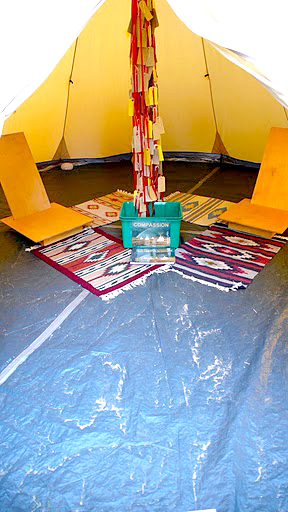 When approaching the artwork one encounters an ordinary white tepee tent standing at the end of the church’s interior, the visitor’s final destination. This tepee is rather ordinary but certainly echoes its Native American origins to house and shelter nomadic tribes from extreme weather and keep one sheltered from danger. It is actually the only true safe haven considering the glassless windows and missing rooftop. The interior of the tepee is quite simple, just two wooden chairs, tribal rugs and a small container with writing supplies. Supported by a metal beam, the tepee is covered by many colourful paper tags filled with text. The artist Keith Calvert calls his work a ‘participatory art installation’ and for good reason: it needs people to empower it. Calvert’s instructions are quite simple: Consider the issue for which you wish to seek or show compassion. Visitors are then encouraged to enter the tepee in silence and choose a paper luggage tag to write on. Feelings and contemplations may be expressed on the tags provided and hung on the centre pole. The rod is now filled with hundreds of colourful luggage tags filled with private musings. Visitors express emotions about world events, deceased loved ones and personal reflections, such as, “Sorry I hurt you, I should have been braver” and “Compassion for a troubled soul, RIP Amy Winehouse”.
When approaching the artwork one encounters an ordinary white tepee tent standing at the end of the church’s interior, the visitor’s final destination. This tepee is rather ordinary but certainly echoes its Native American origins to house and shelter nomadic tribes from extreme weather and keep one sheltered from danger. It is actually the only true safe haven considering the glassless windows and missing rooftop. The interior of the tepee is quite simple, just two wooden chairs, tribal rugs and a small container with writing supplies. Supported by a metal beam, the tepee is covered by many colourful paper tags filled with text. The artist Keith Calvert calls his work a ‘participatory art installation’ and for good reason: it needs people to empower it. Calvert’s instructions are quite simple: Consider the issue for which you wish to seek or show compassion. Visitors are then encouraged to enter the tepee in silence and choose a paper luggage tag to write on. Feelings and contemplations may be expressed on the tags provided and hung on the centre pole. The rod is now filled with hundreds of colourful luggage tags filled with private musings. Visitors express emotions about world events, deceased loved ones and personal reflections, such as, “Sorry I hurt you, I should have been braver” and “Compassion for a troubled soul, RIP Amy Winehouse”.
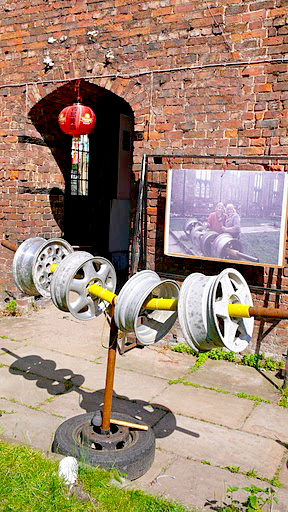 The real strength of the installation lies in the archaic beauty and poetic sanctuary provided by the decayed space and surrounding gardens. Caretakers manage the plot of land by planting flowers, spreading artworks and oddities around the grounds, and playing loud classical music throughout the day. Where else can one bang on homemade instruments made of discarded car parts and attend an outdoor movie night screening of the 1952 musical Singing In the Rain or the 1956 sci-fi classic Forbidden Planet for a small donation?
The real strength of the installation lies in the archaic beauty and poetic sanctuary provided by the decayed space and surrounding gardens. Caretakers manage the plot of land by planting flowers, spreading artworks and oddities around the grounds, and playing loud classical music throughout the day. Where else can one bang on homemade instruments made of discarded car parts and attend an outdoor movie night screening of the 1952 musical Singing In the Rain or the 1956 sci-fi classic Forbidden Planet for a small donation?
Compassion is on view through 31 August, Thursday through Sunday, with a £1 donation to enter, however the church has an on-going programme of music, film nights and art activities. The Bombed-Out Church is located at the corner of Berry Street and Leece Street, opposite Bold Street in Liverpool, England and scheduled to remain open to the public until 2013.
José Carlos Diaz is an independent cultural historian based in Liverpool, England.

